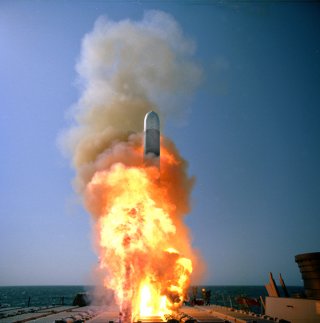The U.S. Navy’s New Tomahawk Missile is a Ship-Killer
The Tomahawk cruise missile has been a staple of U.S. naval power since the early 1980s, hitting targets on land in many conflicts over the decades.
The Tomahawk cruise missile has been a staple of U.S. naval power since the early 1980s, hitting targets on land in many conflicts over the decades.
The subsonic missile is typically launched from U.S. Navy ships, and Raytheon, the Tomahawk manufacturer, claims that more than 2,300 Tomahawks have been fired in anger since the missile was introduced into American service.
Currently, the most advanced Tomahawk in U.S. service is the Block IV variant. This Tomahawk is equipped with a data link that allows for on-the-fly retargeting. It also has a long loiter capability, which allows the missile to wait for an opportune time to hit a target. It can also change course on command, keeping a human operator in the loop.
Since introduced into service, the Tomahawk has been steadily upgraded — and the new Tomahawks will be even more potent.
Here Comes the Block V
The Block V Tomahawks successfully completed flight tests earlier last year and featured communications and navigation improvements. During the flight tests, the Tomahawks were redirected to new targets while in mid-flight. The new Block V Tomahawks are actually a group of three sub-variants, which according to Raytheon, are categorized as follows:
Block V: A modernized TACTOM with upgraded navigation and communication;
Block Va: Block V that can strike moving targets at sea;
Block Vb: Block V, with a joint multi-effects warhead that can hit more diverse land targets.
“These tests keep the Navy on schedule to introduce Block V into the fleet next year,” said a Raytheon Vice President, commenting after last year's Tomahawk Block V trials. “Our modernization and recertification efforts will also extend the missile’s service life by 15 years.”
In addition to longer service life, the new Tomahawk’s range is expected to be longer as well, estimated at greater than 1,000 miles, and would be particularly useful in the Indo-Pacific region, where advancements in China’s missile range capabilities are seen as a threat by the Navy.
It’s not just the Navy that has a clear use for the missile however, the U.S. Marine Corps (USMC) would also have a use for the powerful, long-range weapon.
As part of the Marine Corps’ shift back to their amphibious heritage from long, grinding land wars in the Middle East, the Corps would like to hold Chinese surface ships at risk from increasingly distant ranges. One of the elements of their force posture redesign would see groups of Marines stationed on remote specks of land throughout the Pacific Ocean, armed with long-range anti-ship missiles, and denying the island's use to an opposing force. You can read more about the Corps’ strategy in the Pacific in this previous National Interest piece.
And while the USMC is making great strides in that direction, the Block V Tomahawk’s 1,000-plus range would quite literally go a long way in countering an increasingly large Chinese fleet.
Caleb Larson is a defense writer based in Europe. He holds a Master of Public Policy and covers U.S. and Russian security, European defense issues, and German politics and culture.

